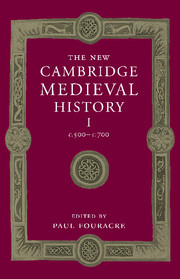Book contents
- Frontmatter
- Introduction: the history of Europe 500–700
- 1 The later Roman Empire
- 2 The Barbarian invasions
- 3 The sources and their interpretation
- PART I THE SIXTH CENTURY
- 4 The Eastern Empire in the sixth century
- 5 The Byzantines in the West in the sixth century
- 6 Ostrogothic Italy and the Lombard invasions
- 7 The formation of the Sueve and Visigothic kingdoms in Spain
- 8 Merovingian Gaul and the Frankish conquests
- 9 The Celtic kingdoms
- 10 The earliest Anglo-Saxon kingdoms
- PART II THE SEVENTH CENTURY
- PART III THEMES AND PROBLEMS
- List of Primary sources
- Bibliography of secondary works arranged by chapter
- Index
- Frontispiece"
- Plate section"
- Map 3 Gaul/Francia in the sixth and seventh centuries"
- References
6 - Ostrogothic Italy and the Lombard invasions
from PART I - THE SIXTH CENTURY
Published online by Cambridge University Press: 28 March 2008
- Frontmatter
- Introduction: the history of Europe 500–700
- 1 The later Roman Empire
- 2 The Barbarian invasions
- 3 The sources and their interpretation
- PART I THE SIXTH CENTURY
- 4 The Eastern Empire in the sixth century
- 5 The Byzantines in the West in the sixth century
- 6 Ostrogothic Italy and the Lombard invasions
- 7 The formation of the Sueve and Visigothic kingdoms in Spain
- 8 Merovingian Gaul and the Frankish conquests
- 9 The Celtic kingdoms
- 10 The earliest Anglo-Saxon kingdoms
- PART II THE SEVENTH CENTURY
- PART III THEMES AND PROBLEMS
- List of Primary sources
- Bibliography of secondary works arranged by chapter
- Index
- Frontispiece"
- Plate section"
- Map 3 Gaul/Francia in the sixth and seventh centuries"
- References
Summary
late antique italy
The situation of Italy during the period now often called ‘late antiquity’ was not always a happy one. The economy was in transition: the number of occupied rural sites began to fall in the third or even the second century, agri deserti were becoming a common feature of the landscape, and towns were losing population. The construction of urban public buildings, one of the distinguishing characteristics of classical civilisation, dried up, and in the early sixth century it was recognised that the population of Rome was much smaller than it had been. As Cassiodorus, a man with long experience in the civil service, wrote: ‘The vast numbers of the people of the city of Rome in old times are evidenced by the extensive provinces from which their food supply was drawn, as well as by the wide circuit of their walls, the massive structure of their amphitheatre, the marvellous bigness of their public baths, and the enormous multitude of mills, which could only have been made for use, not for ornament.’ The role Italy played in the economic life of the Roman Empire diminished, imported African pottery having come to dominate the Italian market as early as the second century, and its political fortunes were similar. While Rome remained for centuries the capital of a mighty empire, there were very few Italian emperors after the first century, and the advent of Constantinople as the ‘second Rome’ from the time of Constantine early in the fourth century saw the eastern and wealthier portion of the Empire become independent.
- Type
- Chapter
- Information
- The New Cambridge Medieval History , pp. 140 - 161Publisher: Cambridge University PressPrint publication year: 2005
References
- 4
- Cited by



